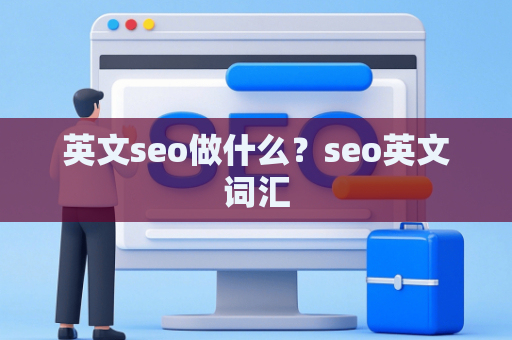Introduction:
In today's digital age, Search Engine Optimization (SEO) has become an indispensable tool for businesses and individuals seeking to establish a strong online presence. With the vast amount of content available on the internet, it is crucial to optimize your website to rank higher in search engine results pages (SERPs). This article delves into the world of English SEO, providing a comprehensive guide to help you optimize your online presence effectively.
1. Understanding English SEO:
Before diving into the specifics of English SEO, it is essential to grasp the fundamental concepts. English SEO refers to the process of optimizing a website to rank higher in search engine results pages for English-speaking users. By implementing effective SEO strategies, you can increase organic traffic, improve user experience, and ultimately achieve your online goals.
2. Keyword Research:
One of the cornerstone elements of English SEO is keyword research. Identifying the right keywords is crucial as it helps search engines understand the content and context of your website. To conduct effective keyword research, follow these steps:
a. Identify your target audience: Understand who your audience is and what they are searching for.
b. Use keyword research tools: Utilize tools like Google Keyword Planner, SEMrush, or Ahrefs to find relevant keywords with high search volume and low competition.
c. ****yze search intent: Determine the intent behind the keywords, whether it is informational, navigational, transactional, or commercial.
3. On-Page Optimization:
On-page optimization involves optimizing various elements on your website to improve its visibility and ranking in search engines. Here are some key aspects to focus on:
a. Title tags: Craft compelling and descriptive title tags that include your primary keyword.
b. Meta descriptions: Write engaging meta descriptions that summarize the content of your page and include the target keyword.
c. Header tags: Use header tags (H1, H2, H3) to structure your content and make it more readable for both users and search engines.
d. Content quality: Produce high-quality, informative, and unique content that provides value to your audience.
e. Internal linking: Create a logical structure of internal links to help search engines crawl your website effectively.
4. Off-Page Optimization:
Off-page optimization refers to activities performed outside of your website to improve its ranking. Here are some effective off-page optimization strategies:
a. Backlinks: Build high-quality backlinks from reputable websites to establish credibility and authority.
b. Guest blogging: Write guest posts for other websites to gain exposure and acquire valuable backlinks.
c. Social media marketing: Utilize social media platforms to promote your content and engage with your audience.
d. Local SEO: Optimize your website for local search by including location-specific keywords, creating a Google My Business listing, and obtaining local citations.

5. Technical SEO:
Technical SEO focuses on improving the technical aspects of your website to enhance its performance and user experience. Here are some crucial technical SEO elements:
a. Website speed: Optimize your website's loading speed by compressing images, leveraging browser caching, and minimizing HTTP requests.
b. Mobile-friendliness: Ensure your website is responsive and provides a seamless experience on mobile devices.
c. Secure website: Implement HTTPS encryption to protect user data and establish trust.
d. Sitemaps and robots.txt: Create XML sitemaps and robots.txt files to help search engines crawl your website effectively.
6. Monitoring and ****ysis:
To measure the success of your English SEO efforts, it is crucial to monitor and ****yze your website's performance. Utilize tools like Google ****ytics and Google Search Console to track metrics such as organic traffic, keyword rankings, and click-through rates. Regularly ****yze the data to identify areas for improvement and refine your SEO strategy.
Conclusion:
English SEO is a dynamic and ever-evolving field. By implementing the strategies outlined in this article, you can optimize your online presence and achieve higher rankings in search engine results. Remember, SEO is an ongoing process, and continuous optimization is essential to stay ahead of the competition. Start implementing these strategies today and unlock the secrets of English SEO to drive more traffic and achieve your online goals.
SEO是SearchEngineOptimization的英文简写,意为搜索引擎优化,或简称“优化”。
SEO是指通过改进网站链接的质量和数量、以及有效的网页内容部署,使网站在搜索引擎上获得比较好的自然排名位置。通常情况下,在搜索一个“关键词”时,搜索引擎会排列出该搜索结果的相关网页,先出现的网站排名越前,网站所获得的访问量就越大。其中:65%—70%的上网者只访问搜索结果的第一页即1—10条信息。20%—25%的上网者访问者访问搜索结果的第二页即11—20条信息。3%—4%的上网者的访问其它所有的搜索结果的总和。
做为重要的网站营销策略,网站经营者必须考虑搜索引擎如何工作,以及人们如何寻找网站。对于企业和商业网站,特别是销售网站而言,每多争取一个访问者,就意味多争取到一个可能的销售线索。我们可以通过关键词分析来定位用户,找到目标客户使用的关键词,然后进行SEO排名优化。
优化网站主要涉及:服务器域名优化、服务器访问速度优化、网站内容及HTML编码的特定关键词TDK设计、消除有障碍的代码、调整链接质量与链接数量。
SEO优化是指通过对网站进行优化和调整,提高其在搜索引擎结果页面的排名,从而增加流量和曝光度的一种策略。目前市面上有许多SEO优化服务提供商,选择哪家好需要综合考虑多方面因素。以下是一些选择SEO优化服务提供商的建议和注意事项:
1. 信誉与口碑:
选择一个具有良好信誉和口碑的SEO优化公司或服务提供商很重要。可以通过查看客户评价、阅读案例研究以及参考其他用户的反馈来了解他们的工作质量和服务水平。
2. 经验与专业知识:
优先选择那些具有丰富经验和专业知识的SEO优化公司。他们对搜索引擎算法和规则有深入的了解,并能够提供全面有效的优化策略。
3. 个性化服务:
不同企业的需求和目标都是不同的,所以选择能够提供个性化定制服务的SEO优化公司非常重要。他们应该能够根据客户的特定需求和目标,制定出适合的优化方案。
4. 成果和报告:
选择一个能够提供透明和可靠成果报告的SEO优化公司是至关重要的。他们应该能够及时汇报工作进展和结果,并根据需求调整优化策略。
5. 成本效益:
虽然价格不应该是唯一的考量因素,但要确保所选择的SEO优化服务提供商能够提供合理的价格和良好的性价比。
需要注意的是,SEO优化是一个长期而复杂的过程,结果并不是立即显现的。因此,选择一家好的SEO优化服务提供商需要慎重考虑,并与他们建立良好的合作关系,以实现长期的在线可见性和市场推广目标。
最后,对于选择合适的SEO优化服务提供商,建议通过咨询业内专家、比较不同公司的服务内容和报价、参考客户评价等方式,进行全面的调查和了解,以做出明智的决策。
可以看看优捷传媒,服务挺好的
夫唯老师告诉你seo主要做这些:
1、把控网站优化健康状态。
早上打开电脑,用SEO工具查看当日的快照,收录,外链变化以及关键词排名变化,每天截一次图,养成习惯后,通过每天的截图对比你就能通过一些微小的变化来发现问题。
2、观察友情链接情况。
第二步就是查看友情链接了,检查友链,防治被牵连。友情链接进行补充和调整,通过每天查看友情链接的情况,你就能知道链接方网站运营的大概状态,及时删除首页不在第一的链接,调整快照更新慢和外链过多的链接。
3、分析网站主要seo流量来源工作。
做推广和营销一定要明白你的目标群体在哪里?通过查看流量来源再加上站内流量转化率,你就能大概知道你的用户群和适合的营销方式。
你可以结合关键词排名情况判断出哪些词能带来流量,你可以通过长尾词带来的流量情况发现哪些长尾词可以加固和扩展。
甚至有时候你会惊奇的发现一个友情链接有时候也能给你带来十几个IP,这些对于你以后的推广策略是很重要的线索。
4、站内文章每天更新工作。
因为前期网站的整个结构都已经调好了,所以网站优化人员主要做的就是添加网站内容。
在这个环节,SEO人员首先要做的就是开始建立关键词库(精准关键词、长尾关键词、短句关键词等)。
站内内容是网站立足之本,注重加紧自己网站内容的建设,优化的重心需要放在站内,每天的站内文章更新必须保持(定时定量更新内容),需要根据行业和需求的不同,每天原创2-5篇文章,这些文章需要根据用户需求制定,采集或伪原创行业新闻、资料、技术文章等内容。
对于文章的标题,除了根据SEO要求建立的关键词库之外,还可以在百度知道,相关搜索找一些相关长尾关键词进行扩展写文章。
5、站外优化工作。
在SEO的日常工作中,这里的站外优化主要指的就是外链工作,简单来说,有以下几点:
(1)、外链的监测
做外链很大一部分是为了推广和引流的作用,监测外链获取的流量和存活的时间周期、来源,更有利于我们今后发布外链的方案。
(2)、外链的更新
持续稳定的发布外链,对于发布时间较长的外链进行必要的更新,有利于外链存活时间更久。
(3)、拓展外链渠道资源
不断拓展新的外链渠道,很多的外链由于管理员删号或发布服务器问题导致外链人工死亡,单一的外链渠道遇到这种情况会让外链数量暴跌,不断拓展新的外链渠道就非常有必要的。
(4)、重点增加权威性网站的外链
外链不在多,而在精,并不是你在所有网站发布的外链都是对你网站非常有利的,发外链应该选择权重高的老站来进行,这些老站在搜索引擎眼里都是具有权威性的站,所以,你网站的外链在具有权威性网站出现才是很有权重,有质量的外链。
(5)、尽量避免制造垃圾外链
文章已关闭评论!
2025-05-09 23:05:13
2025-05-09 22:45:22
2025-05-09 22:33:25
2025-05-09 22:22:51
2025-05-09 22:01:11
2025-05-09 21:15:02
2025-05-09 21:02:22
2025-05-09 20:43:13